Global Research Trends in Consumer Behavior and Sustainability in E-Commerce: A Bibliometric Analysis of the Knowledge Structure
Abstract
:1. Introduction
2. Consumer Behavior and Sustainability in E-Commerce: Related Studies
3. Methodology
3.1. Selection Strategy
3.2. Data Extraction and Analysis
4. Analysis and Results
4.1. Annual Scientific Production
4.2. Journal Performance
4.3. Overview of Influential Publications
| Article | Title | TC | Average TC per Year | Normalized TC |
|---|---|---|---|---|
| [28] | The role of values in collaborative consumption: insights from a product-service system for lending and borrowing in the UK | 198 | 24.750 | 1.960 |
| [60] | The Relationship of E-Commerce Competence to Customer Value and Firm Performance: An Empirical Investigation | 89 | 4.944 | 1.000 |
| [15] | Carbon emissions in a dual channel closed loop supply chain: the impact of consumer free riding behavior | 85 | 12.143 | 1.770 |
| [58] | Managing the effectiveness of e-commerce platforms in a pandemic | 71 | 35.500 | 14.809 |
| [32] | Consumer motives for peer-to-peer sharing | 71 | 14.200 | 2.038 |
| [61] | Relationship between Convenience, Perceived Value, and Repurchase Intention in Online Shopping in Vietnam | 63 | 12.600 | 1.808 |
| [62] | Limits to growth in the new economy: exploring the “get big fast” strategy in e-commerce | 53 | 2.650 | 1.000 |
| [51] | Dual-channel structure choice of an environmental responsibility supply chain with green investment | 52 | 13.000 | 2.955 |
| [63] | The influence of e-services on customer online purchasing behavior toward remanufactured products | 50 | 8.333 | 1.667 |
| [10] | The Effects of Online Shopping Context Cues on Consumers’ Purchase Intention for Cross-Border E-Commerce Sustainability | 37 | 9.250 | 2.102 |
4.4. Authors’ Performance Analysis
4.5. Authors’ Keywords Analysis
5. Future Research Directions
6. Conclusions and Limitations
Author Contributions
Funding
Institutional Review Board Statement
Data Availability Statement
Conflicts of Interest
References
- Keenan, M. Global Ecommerce Explained: Stats and Trends to Watch in 2022. Available online: https://www.shopify.com/enterprise/global-ecommerce-statistics#2 (accessed on 12 May 2022).
- von Abrahams, K. Global Ecommerce Forecast. 2021. Available online: https://www.emarketer.com/content/global-ecommerce-forecast-2021 (accessed on 12 May 2022).
- Wagner, G.; Schramm-Klein, H.; Steinmann, S. Online Retailing across E-Channels and e-Channel Touchpoints: Empirical Studies of Consumer Behavior in the Multichannel e-Commerce Environment. J. Bus. Res. 2020, 107, 256–270. [Google Scholar] [CrossRef]
- Kondo, F.N.; Okubo, T. Understanding Multi-Channel Consumer Behavior: A Comparison between Segmentations of Multi-Channel Purchases by Product Category and Overall Products. J. Retail. Consum. Serv. 2022, 64, 102792. [Google Scholar] [CrossRef]
- Chen, Y.; Cheung, C.M.K.; Tan, C.-W. Omnichannel Business Research: Opportunities and Challenges. Decis. Support Syst. 2018, 109, 1–4. [Google Scholar] [CrossRef]
- Rita, P.; Oliveira, T.; Farisa, A. The Impact of E-Service Quality and Customer Satisfaction on Customer Behavior in Online Shopping. Heliyon 2019, 5, e02690. [Google Scholar] [CrossRef] [PubMed] [Green Version]
- Ramos, R.F.; Rita, P.; Moro, S. Is This the Beginning of the End for Retail Websites A Professional Perspective. Int. J. Internet Mark. Advert. 2021, 15, 260–280. [Google Scholar] [CrossRef]
- Rita, P.; Ramos, R.; Borges-Tiago, M.T.; Rodrigues, D. Impact of the Rating System on Sentiment and Tone of Voice: A Booking.com and TripAdvisor Comparison Study. Int. J. Hosp. Manag. 2022, 104, 103245. [Google Scholar] [CrossRef]
- Escursell, S.; Llorach-Massana, P.; Roncero, M.B. Sustainability in E-Commerce Packaging: A Review. J. Clean. Prod. 2021, 280, 124314. [Google Scholar] [CrossRef]
- Xiao, L.; Guo, F.; Yu, F.; Liu, S. The Effects of Online Shopping Context Cues on Consumers’ Purchase Intention for Cross-Border E-Commerce Sustainability. Sustainability 2019, 11, 2777. [Google Scholar] [CrossRef] [Green Version]
- D’Adamo, I.; González-Sánchez, R.; Medina-Salgado, M.S.; Settembre-Blundo, D. E-Commerce Calls for Cyber-Security and Sustainability: How European Citizens Look for a Trusted Online Environment. Sustainability 2021, 13, 6752. [Google Scholar] [CrossRef]
- Oláh, J.; Kitukutha, N.; Haddad, H.; Pakurár, M.; Máté, D.; Popp, J. Achieving Sustainable E-Commerce in Environmental, Social and Economic Dimensions by Taking Possible Trade-Offs. Sustainability 2018, 11, 89. [Google Scholar] [CrossRef] [Green Version]
- Siragusa, C.; Tumino, A.; Mangiaracina, R.; Perego, A. Electric Vehicles Performing Last-Mile Delivery in B2C e-Commerce: An Economic and Environmental Assessment. Int. J. Sustain. Transp. 2022, 16, 22–33. [Google Scholar] [CrossRef]
- Nogueira, G.P.M.; de Assis Rangel, J.J.; Shimoda, E. Sustainable Last-Mile Distribution in B2C e-Commerce: Do Consumers Really Care? Clean. Responsible Consum. 2021, 3, 100021. [Google Scholar] [CrossRef]
- He, R.; Xiong, Y.; Lin, Z. Carbon Emissions in a Dual Channel Closed Loop Supply Chain: The Impact of Consumer Free Riding Behavior. J. Clean. Prod. 2016, 134, 384–394. [Google Scholar] [CrossRef] [Green Version]
- Priyan, S.; Udayakumar, R.; Mala, P.; Prabha, M.; Ghosh, A. A Sustainable Dual-Channel Inventory Model with Trapezoidal Fuzzy Demand and Energy Consumption. Clean. Eng. Technol. 2022, 6, 100400. [Google Scholar] [CrossRef]
- Creativity in Packaging Design as a Competitive Promotional Tool. Inf. Sci. Lett. 2022, 11, 135–148. [CrossRef]
- Webster, J.; Watson, R. Analyzing the Past to Prepare for the Future: Writting a Literature Review. Manag. Inf. Syst. Q. 2002, 26, 13–23. [Google Scholar]
- Paul, J.; Merchant, A.; Dwivedi, Y.K.; Rose, G. Writing an Impactful Review Article: What Do We Know and What Do We Need to Know? J. Bus. Res. 2021, 133, 337–340. [Google Scholar] [CrossRef]
- Aria, M.; Cuccurullo, C. Bibliometrix: An R-Tool for Comprehensive Science Mapping Analysis. J. Informetr. 2017, 11, 959–975. [Google Scholar] [CrossRef]
- Aria, M.; Alterisio, A.; Scandurra, A.; Pinelli, C.; D’Aniello, B. The Scholar’s Best Friend: Research Trends in Dog Cognitive and Behavioral Studies. Anim. Cogn. 2021, 24, 541–553. [Google Scholar] [CrossRef]
- Broadus, R.N. Toward a Definition of “Bibliometrics”. Scientometrics 1987, 12, 373–379. [Google Scholar] [CrossRef]
- Kang, K.; Hong, K.; Kim, K.H.; Lee, C. Shipment Consolidation Policy under Uncertainty of Customer Order for Sustainable Supply Chain Management. Sustainability 2017, 9, 1675. [Google Scholar] [CrossRef] [Green Version]
- Quevedo-Silva, F.; Freire, O.; Lima-Filho, D.d.O.; Brandão, M.M.; Isabella, G.; Moreira, L.B. Intentions to Purchase Food through the Internet: Developing and Testing a Model. Br. Food J. 2016, 118, 572–587. [Google Scholar] [CrossRef]
- Qureshi, M.I.; Khan, N.; Hassan Gillani, S.M.A.; Raza, H. A Systematic Review of Past Decade of Mobile Learning: What We Learned and Where to Go. Int. J. Interact. Mob. Technol. 2020, 14, 67. [Google Scholar] [CrossRef]
- Kiba-Janiak, M.; Marcinkowski, J.; Jagoda, A.; Skowrońska, A. Sustainable Last Mile Delivery on E-Commerce Market in Cities from the Perspective of Various Stakeholders. Literature Review. Sustain. Cities Soc. 2021, 71, 102984. [Google Scholar] [CrossRef]
- Carr-Chellman, A.A. Where Do Educational Technologists Really Publish? An Examination of Successful Emerging Scholars’ Publication Outlets. Br. J. Educ. Technol. 2006, 37, 5–15. [Google Scholar] [CrossRef]
- Piscicelli, L.; Cooper, T.; Fisher, T. The Role of Values in Collaborative Consumption: Insights from a Product-Service System for Lending and Borrowing in the UK. J. Clean. Prod. 2015, 97, 21–29. [Google Scholar] [CrossRef] [Green Version]
- Belk, R. You Are What You Can Access: Sharing and Collaborative Consumption Online. J. Bus. Res. 2014, 67, 1595–1600. [Google Scholar] [CrossRef]
- Hamari, J.; Sjöklint, M.; Ukkonen, A. The Sharing Economy: Why People Participate in Collaborative Consumption. J. Assoc. Inf. Sci. Technol. 2016, 67, 2047–2059. [Google Scholar] [CrossRef]
- Frenken, K.; Schor, J. Putting the Sharing Economy into Perspective. In A Research Agenda for Sustainable Consumption Governance; Edward Elgar Publishing: Cheltenham, UK, 2019. [Google Scholar]
- Hawlitschek, F.; Teubner, T.; Gimpel, H. Consumer Motives for Peer-to-Peer Sharing. J. Clean. Prod. 2018, 204, 144–157. [Google Scholar] [CrossRef]
- Arman, S.M.; Mark-Herbert, C. Ethical Pro-Environmental Self-Identity Practice: The Case of Second-Hand Products. Sustainability 2022, 14, 2154. [Google Scholar] [CrossRef]
- Rao, C.; Goh, M.; Zhao, Y.; Zheng, J. Location Selection of City Logistics Centers under Sustainability. Transp. Res. Part D Transp. Environ. 2015, 36, 29–44. [Google Scholar] [CrossRef]
- Villa, R.; Monzón, A. A Metro-Based System as Sustainable Alternative for Urban Logistics in the Era of E-Commerce. Sustainability 2021, 13, 4479. [Google Scholar] [CrossRef]
- Ignat, B.; Chankov, S. Do E-Commerce Customers Change Their Preferred Last-Mile Delivery Based on Its Sustainability Impact? Int. J. Logist. Manag. 2020, 31, 521–548. [Google Scholar] [CrossRef]
- Gatta, V.; Marcucci, E.; Maltese, I.; Iannaccone, G.; Fan, J. E-Groceries: A Channel Choice Analysis in Shanghai. Sustainability 2021, 13, 3625. [Google Scholar] [CrossRef]
- Quezado, T.C.C.; Cavalcante, W.Q.F.; Fortes, N.; Ramos, R.F. Corporate Social Responsibility and Marketing: A Bibliometric and Visualization Analysis of the Literature between the Years 1994 and 2020. Sustainability 2022, 14, 1694. [Google Scholar] [CrossRef]
- Randhawa, K.; Wilden, R.; Hohberger, J. A Bibliometric Review of Open Innovation: Setting a Research Agenda. J. Prod. Innov. Manag. 2016, 33, 750–772. [Google Scholar] [CrossRef]
- Kumar, S.; Sureka, R.; Vashishtha, A. The Journal of Heritage Tourism: A Bibliometric Overview since Its Inception. J. Herit. Tour. 2020, 15, 365–380. [Google Scholar] [CrossRef]
- Santos, Z.R.; Cheung, C.M.K.; Coelho, P.S.; Rita, P. Consumer Engagement in Social Media Brand Communities: A Literature Review. Int. J. Inf. Manag. 2022, 63, 102457. [Google Scholar] [CrossRef]
- Ramos, R.F.; Rita, P.; Moro, S. From Institutional Websites to Social Media and Mobile Applications: A Usability Perspective. Eur. Res. Manag. Bus. Econ. 2019, 25, 138–143. [Google Scholar] [CrossRef]
- Jia, F.; Jiang, Y. Sustainable Global Sourcing: A Systematic Literature Review and Bibliometric Analysis. Sustainability 2018, 10, 595. [Google Scholar] [CrossRef] [Green Version]
- Cano, J.A.; Londoño-Pineda, A.; Castro, M.F.; Paz, H.B.; Rodas, C.; Arias, T. A Bibliometric Analysis and Systematic Review on E-Marketplaces, Open Innovation, and Sustainability. Sustainability 2022, 14, 5456. [Google Scholar] [CrossRef]
- Nova-Reyes, A.; Muñoz-Leiva, F.; Luque-Martínez, T. The Tipping Point in the Status of Socially Responsible Consumer Behavior Research? A Bibliometric Analysis. Sustainability 2020, 12, 3141. [Google Scholar] [CrossRef] [Green Version]
- Kim; So, K.K.F. Two Decades of Customer Experience Research in Hospitality and Tourism: A Bibliometric Analysis and Thematic Content Analysis. Int. J. Hosp. Manag. 2022, 100, 103082. [Google Scholar] [CrossRef]
- Rojas-Lamorena, Á.J.; Del Barrio-García, S.; Alcántara-Pilar, J.M. A Review of Three Decades of Academic Research on Brand Equity: A Bibliometric Approach Using Co-Word Analysis and Bibliographic Coupling. J. Bus. Res. 2022, 139, 1067–1083. [Google Scholar] [CrossRef]
- Leone, R.P.; Robinson, L.M.; Bragge, J.; Somervuori, O. A Citation and Profiling Analysis of Pricing Research from 1980 to 2010. J. Bus. Res. 2012, 65, 1010–1024. [Google Scholar] [CrossRef]
- Sharma, P.; Singh, R.; Tamang, M.; Singh, A.K.; Singh, A.K. Journal of Teaching in Travel & Tourism: A Bibliometric Analysis. J. Teach. Travel Tour. Tour. 2021, 21, 155–176. [Google Scholar] [CrossRef]
- Malaga, R.A. Consumer Costs in Electronic Commerce: An Empirical Examination of Electronic Versus Traditional Markets. J. Organ. Comput. Electron. Commer. 2001, 11, 47–58. [Google Scholar] [CrossRef]
- Yang, D.; Xiao, T.; Huang, J. Dual-Channel Structure Choice of an Environmental Responsibility Supply Chain with Green Investment. J. Clean. Prod. 2019, 210, 134–145. [Google Scholar] [CrossRef]
- Rai, H.; Verlinde, S.; Macharis, C. The “next day, free delivery” myth unravelled: Possibilities for sustainable last mile transport in an omnichannel environment. Int. J. Retail Distrib. Manag. 2019, 47, 39–54. [Google Scholar] [CrossRef]
- Hirsch, J.E. An Index to Quantify an Individual’s Scientific Research Output. Proc. Natl. Acad. Sci. USA 2005, 102, 16569–16572. [Google Scholar] [CrossRef] [Green Version]
- Egghe, L. Theory and Practise of the G-Index. Scientometrics 2006, 69, 131–152. [Google Scholar] [CrossRef]
- Halbach, O. How to Judge a Book by Its Cover? How Useful Are Bibliometric Indices for the Evaluation of “Scientific Quality” or “Scientific Productivity”? Ann. Anat.-Anat. Anz. 2011, 193, 191–196. [Google Scholar] [CrossRef] [PubMed]
- Sustainability. About Sustainability. Available online: https://www.mdpi.com/journal/sustainability/about (accessed on 5 May 2022).
- Cebrino, J.; de la Cruz, S.P. A Worldwide Bibliometric Analysis of Published Literature on Workplace Violence in Healthcare Personnel. PLoS ONE 2020, 15, e0242781. [Google Scholar] [CrossRef] [PubMed]
- Tran, L.T.T. Managing the Effectiveness of E-Commerce Platforms in a Pandemic. J. Retail. Consum. Serv. 2021, 58, 102287. [Google Scholar] [CrossRef]
- Bornmann, L.; Marx, W. Methods for the Generation of Normalized Citation Impact Scores in Bibliometrics: Which Method Best Reflects the Judgements of Experts? J. Informetr. 2015, 9, 408–418. [Google Scholar] [CrossRef] [Green Version]
- Saeed, K.; Grover, V.; Hwang, Y. The Relationship of E-Commerce Competence to Customer Value and Firm Performance: An Empirical Investigation. J. Manag. Inf. Syst. 2005, 22, 223–256. [Google Scholar] [CrossRef]
- Pham, Q.; Tran, X.; Misra, S.; Maskeliūnas, R.; Damaševičius, R. Relationship between Convenience, Perceived Value, and Repurchase Intention in Online Shopping in Vietnam. Sustainability 2018, 10, 156. [Google Scholar] [CrossRef] [Green Version]
- Oliva, R.; Sterman, J.D.; Giese, M. Limits to Growth in the New Economy: Exploring the ?Get Big Fast? Strategy in e-Commerce. Syst. Dyn. Rev. 2003, 19, 83–117. [Google Scholar] [CrossRef]
- Xu, X.; Zeng, S.; He, Y. The Influence of E-Services on Customer Online Purchasing Behavior toward Remanufactured Products. Int. J. Prod. Econ. 2017, 187, 113–125. [Google Scholar] [CrossRef]
- Nerur, S.P.; Rasheed, A.A.; Natarajan, V. The Intellectual Structure of the Strategic Management Field: An Author Co-Citation Analysis. Strateg. Manag. J. 2008, 29, 319–336. [Google Scholar] [CrossRef]
- Berry, L.L.; Parasuraman, A. Building a New Academic Field—The Case of Services Marketing. J. Retail. 1993, 69, 13–60. [Google Scholar] [CrossRef]
- Rai, H.; Mommens, K.; Verlinde, S.; Macharis, C. How Does Consumers’ Omnichannel Shopping Behaviour Translate into Travel and Transport Impacts? Case-Study of a Footwear Retailer in Belgium. Sustainability 2019, 11, 2534. [Google Scholar] [CrossRef] [Green Version]
- Rai, H.; Broekaert, C.; Verlinde, S.; Macharis, C. Sharing Is Caring: How Non-Financial Incentives Drive Sustainable e-Commerce Delivery. Transp. Res. Part D Transp. Environ. 2021, 93, 102794. [Google Scholar] [CrossRef]
- Cuccurullo, C.; Aria, M.; Sarto, F. Foundations and Trends in Performance Management. A Twenty-Five Years Bibliometric Analysis in Business and Public Administration Domains. Scientometrics 2016, 108, 595–611. [Google Scholar] [CrossRef]
- Donthu, N.; Kumar, S.; Pattnaik, D.; Lim, W.M. A Bibliometric Retrospection of Marketing from the Lens of Psychology: Insights from Psychology & Marketing. Psychol. Mark. 2021, 38, 834–865. [Google Scholar] [CrossRef]
- Eduardsen, J.; Marinova, S. Internationalisation and Risk: Literature Review, Integrative Framework and Research Agenda. Int. Bus. Rev. 2020, 29, 101688. [Google Scholar] [CrossRef]
- Caspersen, E.; Navrud, S. The Sharing Economy and Consumer Preferences for Environmentally Sustainable Last Mile Deliveries. Transp. Res. Part D Transp. Environ. 2021, 95, 102863. [Google Scholar] [CrossRef]
- Cobo, M.J.; López-Herrera, A.G.; Herrera-Viedma, E.; Herrera, F. An Approach for Detecting, Quantifying, and Visualizing the Evolution of a Research Field: A Practical Application to the Fuzzy Sets Theory Field. J. Informetr. 2011, 5, 146–166. [Google Scholar] [CrossRef]
- Le, T.; Liaw, S.-Y. Effects of Pros and Cons of Applying Big Data Analytics to Consumers’ Responses in an E-Commerce Context. Sustainability 2017, 9, 798. [Google Scholar] [CrossRef] [Green Version]
- Zhang, Y.; Nguyen, D.-D. What Makes Consumers Willing to Pay for Online Services? Discovering Consumer Opinions and Determinant Factors on Charged Online Services. J. Internet Commer. 2004, 2, 35–53. [Google Scholar] [CrossRef]
- Jílková, P.; Králová, P. Digital Consumer Behaviour and ECommerce Trends during the COVID-19 Crisis. Int. Adv. Econ. Res. 2021, 27, 83–85. [Google Scholar] [CrossRef]
- Clausen, J.; Blättel-Mink, B.; Erdmann, L.; Henseling, C. Contribution of Online Trading of Used Goods to Resource Efficiency: An Empirical Study of EBay Users. Sustainability 2010, 2, 1810–1830. [Google Scholar] [CrossRef] [Green Version]
- Raman, P. Examining the Importance of Gamification, Social Interaction and Perceived Enjoyment among Young Female Online Buyers in India. Young Consum. 2021, 22, 387–412. [Google Scholar] [CrossRef]
- Tzavlopoulos, Ι.; Gotzamani, K.; Andronikidis, A.; Vassiliadis, C. Determining the Impact of E-Commerce Quality on Customers’ Perceived Risk, Satisfaction, Value and Loyalty. Int. J. Qual. Serv. Sci. 2019, 11, 576–587. [Google Scholar] [CrossRef]
- Zheng, Q.; Xu, A.; Su, X.; Zhao, R. Effects of Online Word-of-Mouth on Brand Trust and Customer Loyalty in Ecotourism Industry. J. Environ. Prot. Ecol. 2020, 21, 2314–2322. [Google Scholar]
- Guo, Y.; Yin, C.; Li, M.; Ren, X.; Liu, P. Mobile E-Commerce Recommendation System Based on Multi-Source Information Fusion for Sustainable e-Business. Sustainability 2018, 10, 147. [Google Scholar] [CrossRef] [Green Version]
- Ebrahimi, P.; Khajeheian, D.; Fekete-Farkas, M. A SEM-NCA Approach towards Social Networks Marketing: Evaluating Consumers’ Sustainable Purchase Behavior with the Moderating Role of Eco-Friendly Attitude. Int. J. Environ. Res. Public Health 2021, 18, 13276. [Google Scholar] [CrossRef]
- Paștiu, C.A.; Oncioiu, I.; Gârdan, D.A.; Maican, S.Ș.; Gârdan, I.P.; Muntean, A.C. The Perspective of E-Business Sustainability and Website Accessibility of Online Stores. Sustainability 2020, 12, 9780. [Google Scholar] [CrossRef]
- Xie, G.; Huang, L.; Apostolidis, C.; Huang, Z.; Cai, W.; Li, G. Assessing Consumer Preference for Overpackaging Solutions in E-Commerce. Int. J. Environ. Res. Public Health 2021, 18, 7951. [Google Scholar] [CrossRef]
- Ingaldi, M.; Ulewicz, R. How to Make E-Commerce More Successful by Use of Kano’s Model to Assess Customer Satisfaction in Terms of Sustainable Development. Sustainability 2019, 11, 4830. [Google Scholar] [CrossRef] [Green Version]
- Bi, Y.; Kim, I. Older Travelers’ E-Loyalty: The Roles of Service Convenience and Social Presence in Travel Websites. Sustainability 2020, 12, 410. [Google Scholar] [CrossRef] [Green Version]
- Lemos, C.; Ramos, R.F.; Moro, S.; Oliveira, P.M. Stick or Twist—The Rise of Blockchain Applications in Marketing Management. Sustainability 2022, 14, 4172. [Google Scholar] [CrossRef]
- Falagas, M.E.; Pitsouni, E.I.; Malietzis, G.A.; Pappas, G. Comparison of PubMed, Scopus, Web of Science, and Google Scholar: Strengths and Weaknesses. FASEB J. 2008, 22, 338–342. [Google Scholar] [CrossRef] [PubMed]
- Vogel, R.; Güttel, W.H. The Dynamic Capability View in Strategic Management: A Bibliometric Review. Int. J. Manag. Rev. 2012, 15, 426–446. [Google Scholar] [CrossRef]
- Hota, P.K.; Subramanian, B.; Narayanamurthy, G. Mapping the Intellectual Structure of Social Entrepreneurship Research: A Citation/Co-Citation Analysis. J. Bus. Ethics 2020, 166, 89–114. [Google Scholar] [CrossRef]
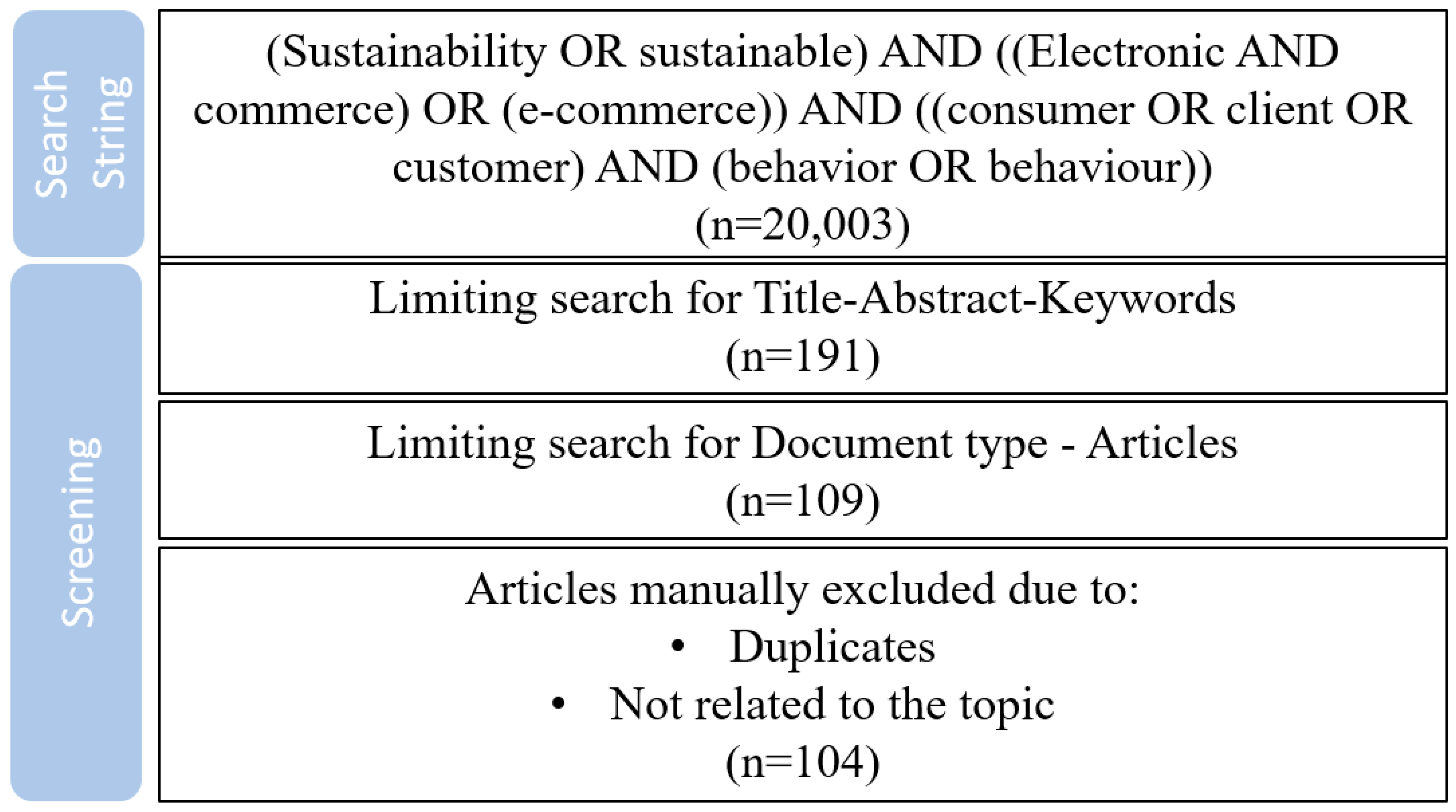
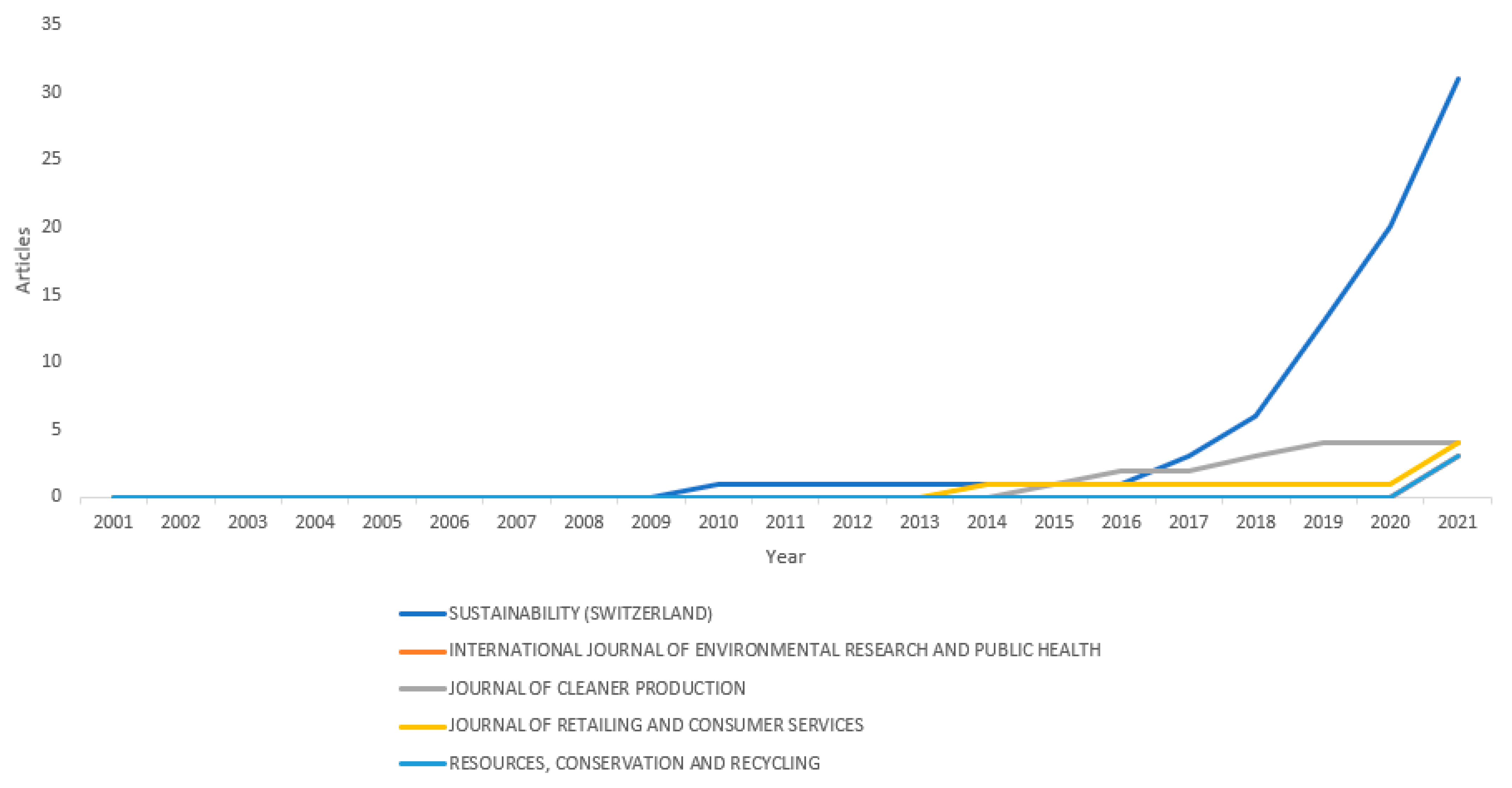
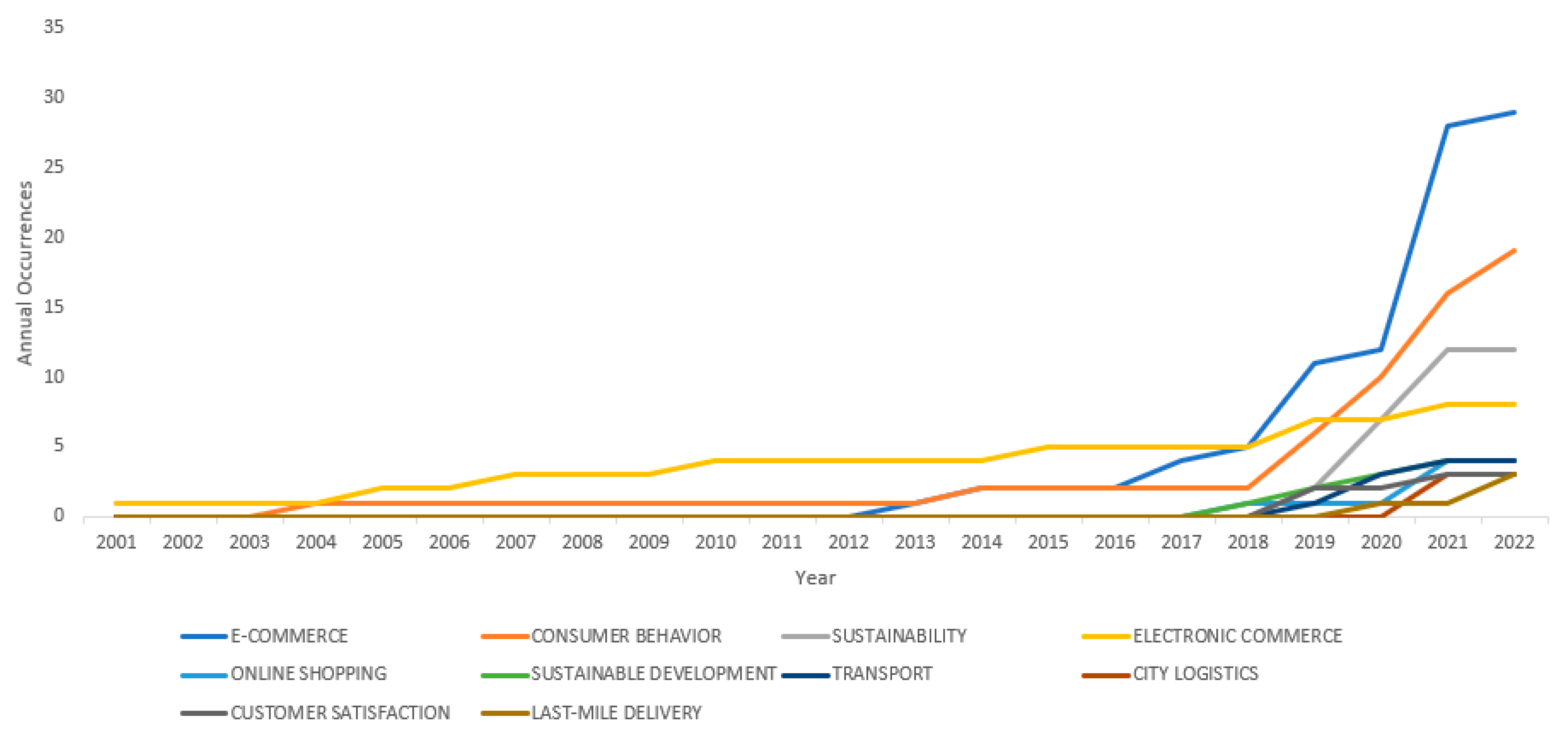
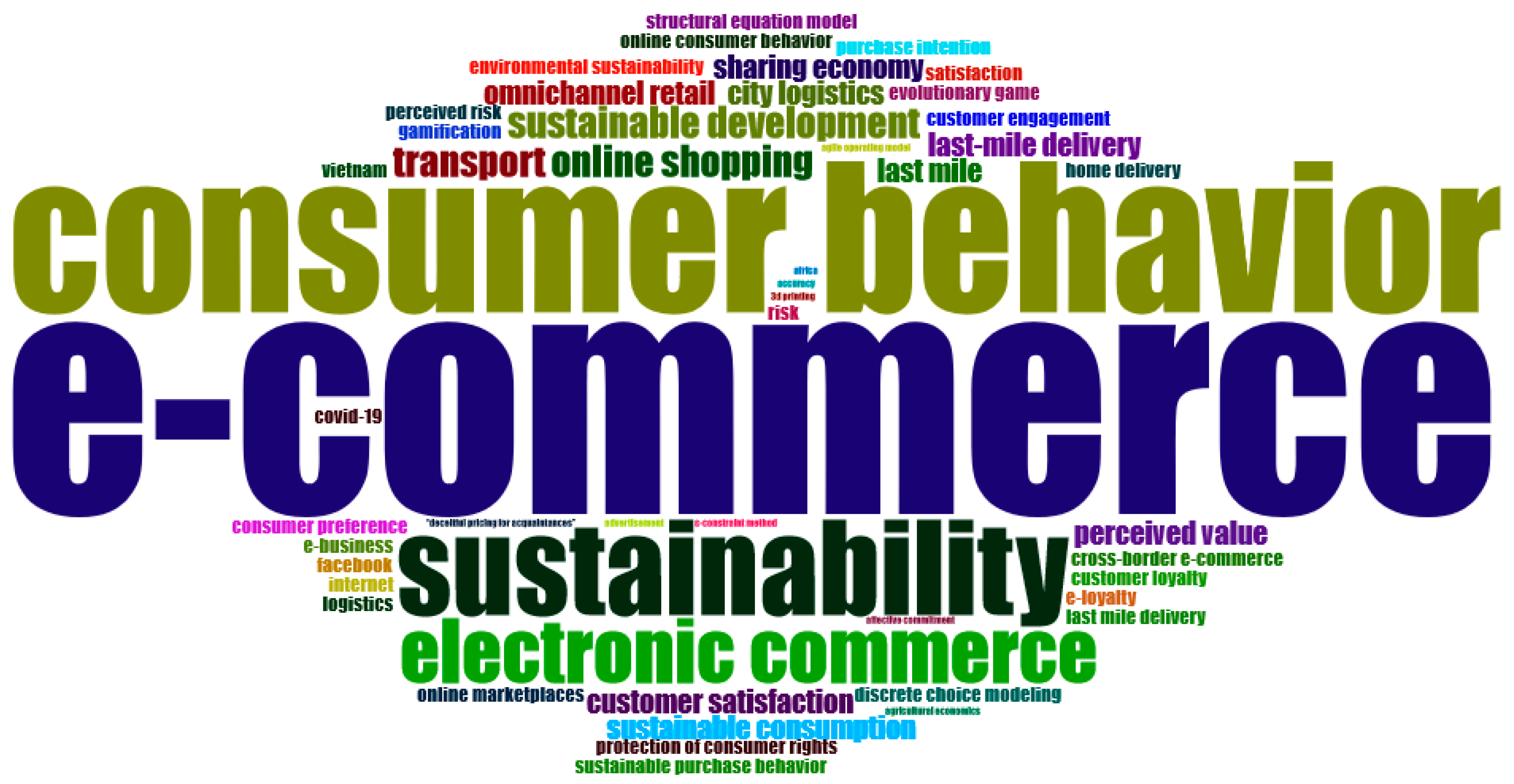
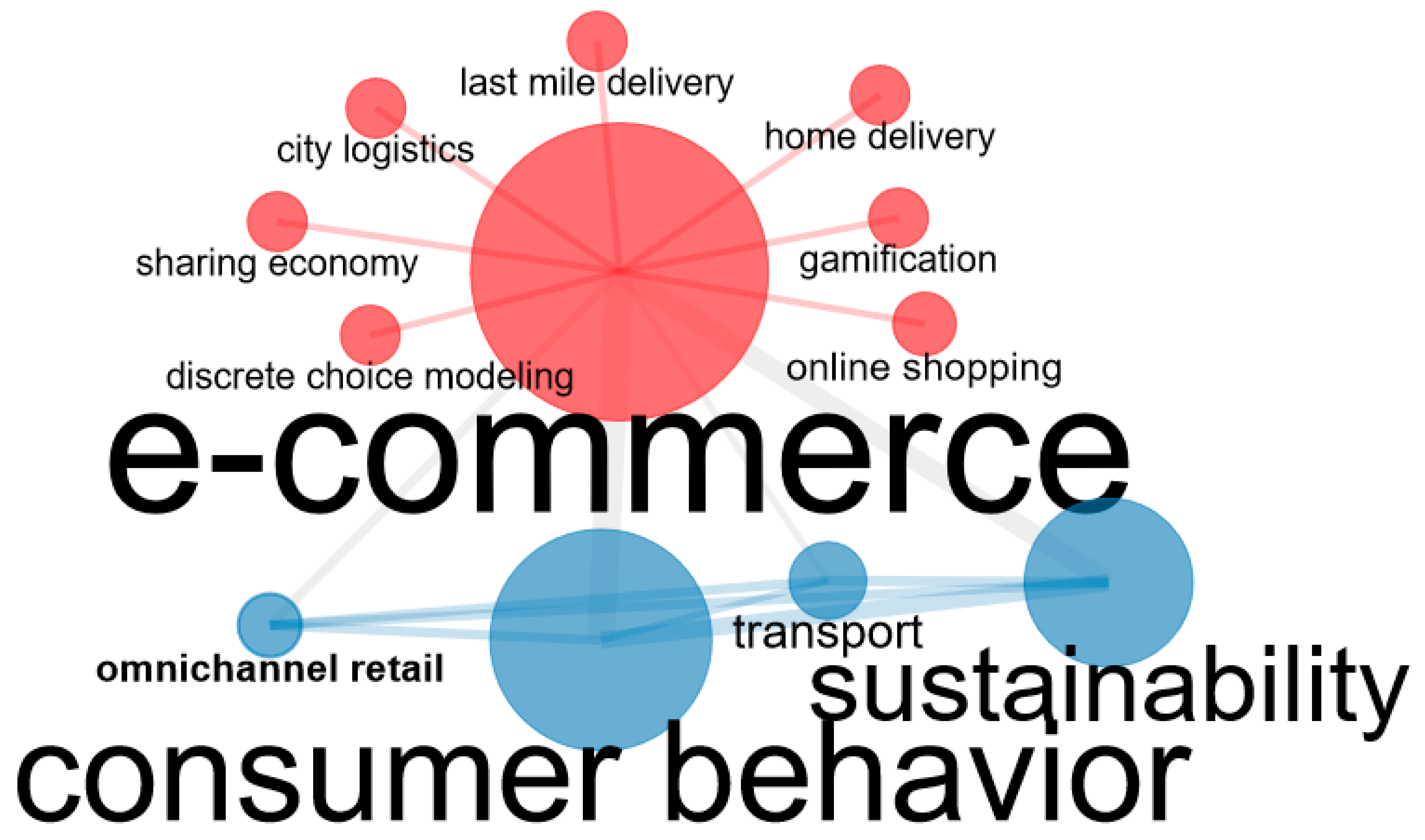
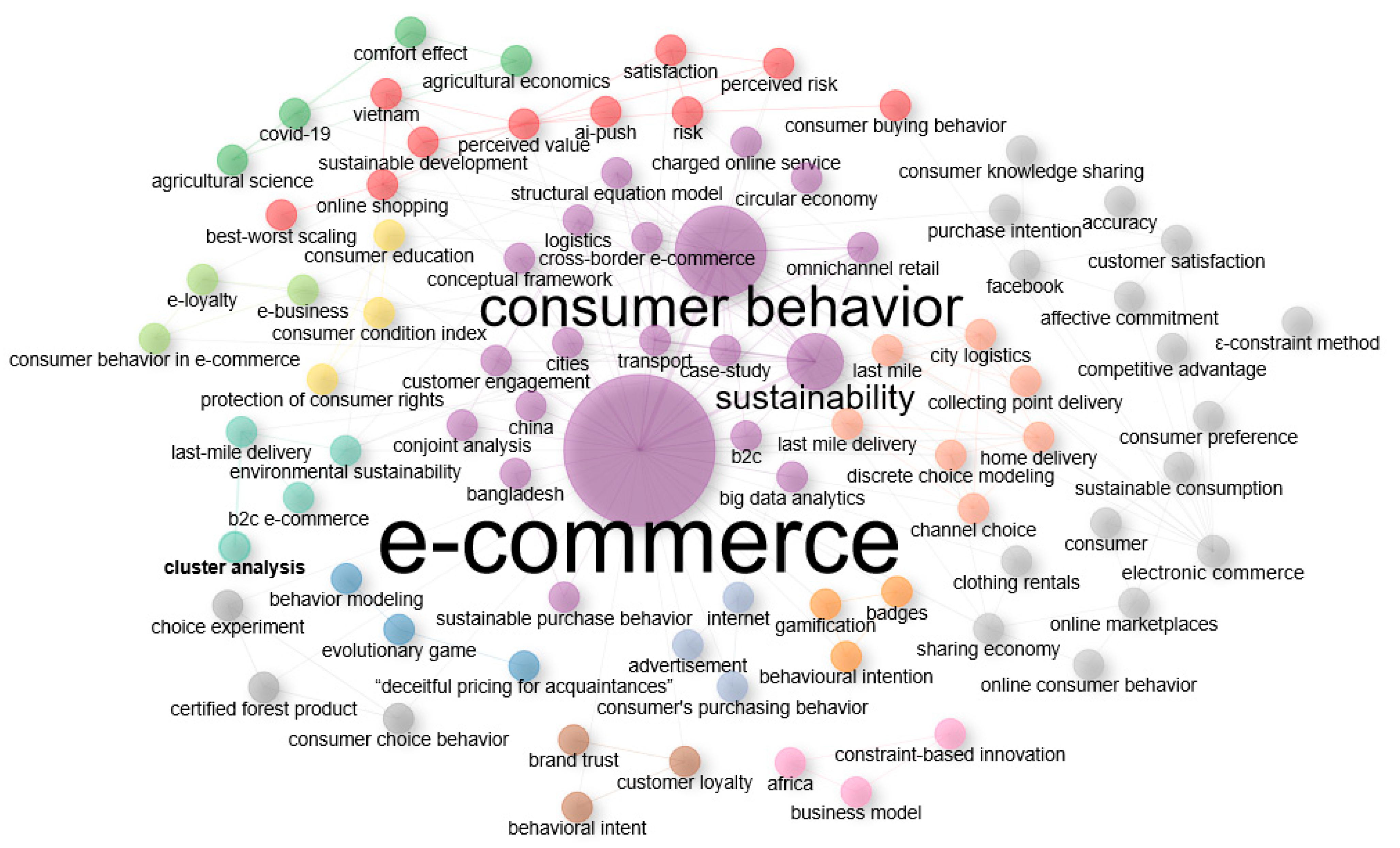
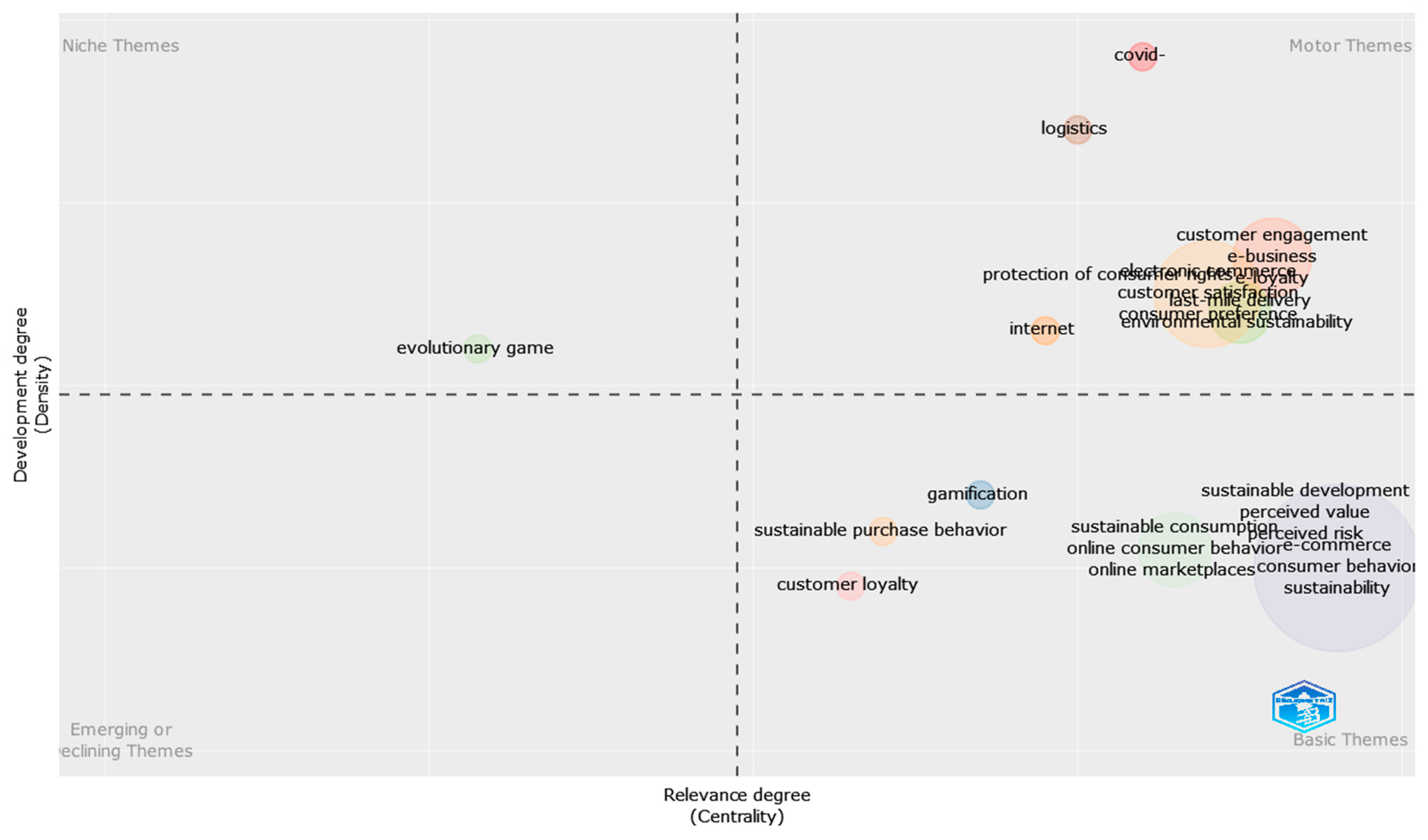
| Description | Results |
|---|---|
| Sources (Journals) | 54 |
| Period | 2001:2022 |
| Document type | Article = 104 |
| Average years from publication | 3.27 |
| Average citations per documents | 13.78 |
| Average citations per year per doc | 3.023 |
| References | 6876 |
| Authors | 342 |
| Authors’ keywords | 441 |
| Authors of single-authored documents | 10 |
| Authors of multi-authored documents | 332 |
| Documents per author | 0.304 |
| Authors per Document | 3.29 |
| Co-Authors per Documents | 3.43 |
| Collaboration Index | 3.53 |
| Variable | Description |
|---|---|
| Authors | Authors’ name |
| Document title | Title of the document |
| Year | Year of publication |
| Source title | Publication source |
| Citation count | Number of citations |
| Keywords | Authors’ keywords |
| Year | N | TC * | Mean TC * per Article | Mean TC * per Year | Citable Years |
|---|---|---|---|---|---|
| 2001 | 1 | 14 | 14 | 0.67 | 21 |
| 2002 | 0 | 0 | 0 | 0 | 0 |
| 2003 | 1 | 53 | 53 | 2.79 | 19 |
| 2004 | 1 | 3 | 3 | 0.17 | 18 |
| 2005 | 1 | 89 | 89 | 5.24 | 17 |
| 2006 | 0 | 0 | 0 | 0 | 0 |
| 2007 | 1 | 6 | 6 | 0.4 | 15 |
| 2008 | 0 | 0 | 0 | 0 | 0 |
| 2009 | 1 | 18 | 18 | 1.38 | 13 |
| 2010 | 1 | 13 | 13 | 10.8 | 12 |
| 2011 | 0 | 0 | 0 | 0 | 0 |
| 2012 | 0 | 0 | 0 | 0 | 0 |
| 2013 | 2 | 10 | 5 | 0.56 | 9 |
| 2014 | 3 | 25 | 8.33 | 1.04 | 8 |
| 2015 | 2 | 202 | 101 | 14.43 | 7 |
| 2016 | 2 | 96 | 48 | 8 | 6 |
| 2017 | 4 | 120 | 30 | 6 | 5 |
| 2018 | 6 | 209 | 34.83 | 8.71 | 4 |
| 2019 | 15 | 264 | 17.60 | 5.87 | 3 |
| 2020 | 17 | 145 | 8.53 | 4.26 | 2 |
| 2021 | 34 | 163 | 4.79 | 4.79 | 1 |
| 2022 | 12 | 3 | 0.25 | - | 0 |
| Total | 104 | 1433 | 13.78 | 0.65 |
| Journal | No. of Articles | SJR | TC | h-Index | g-Index | m-Index |
|---|---|---|---|---|---|---|
| Sustainability | 34 | Q1 | 418 | 12 | 19 | 0.923 |
| International Journal of Environmental Research and Public Health | 4 | Q1 | 2 | 1 | 1 | 0.500 |
| Journal of Cleaner Production | 4 | Q1 | 406 | 4 | 4 | 0.500 |
| Journal of Retailing and Consumer Services | 4 | Q1 | 92 | 3 | 4 | 0.333 |
| Resources Conservation and Recycling | 3 | Q1 | 14 | 3 | 3 | 1.500 |
| International Journal of Quality and Service Sciences | 2 | Q2 | 23 | 1 | 1 | 0.250 |
| International Journal of Retail and Distribution Management | 2 | Q1 | 43 | 2 | 2 | 0.125 |
| International Review of Retail Distribution and Consumer Research | 2 | Q2 | 8 | 2 | 2 | 0.500 |
| Rivista di Studi Sulla Sostenibilita | 2 | Q3 | 8 | 1 | 1 | 0.200 |
| Sustainable Production and Consumption | 2 | Q1 | 0 | - | - | - |
| Transportation Research, Part D: Transport and Environment | 2 | Q1 | 10 | 2 | 2 | 1.000 |
| Advanced Engineering Informatics | 1 | Q1 | 18 | 1 | 1 | 0.500 |
| Amfiteatru Economic | 1 | Q2 | 4 | 1 | 1 | 0.111 |
| Asian Social Science | 1 | Q3 | 4 | 1 | 1 | 0.125 |
| British Food Journal | 1 | Q2 | 6 | 1 | 1 | 0.333 |
| Business Perspectives and Research | 1 | Q3 | 10 | 1 | 1 | 0.100 |
| Cleaner and Responsible Consumption | 1 | - | 3 | 1 | 1 | 0.500 |
| Cleaner Engineering and Technology | 1 | - | 0 | - | - | - |
| Emerald Emerging Markets Case Studies | 1 | Q3 | 0 | - | - | - |
| Energy Efficiency | 1 | Q2 | 9 | 1 | 1 | 0.333 |
| Environmental Science and Technology | 1 | - | 18 | 1 | 1 | 0.071 |
| Foresight | 1 | Q2 | 0 | |||
| Forests | 1 | Q1 | 6 | 1 | 1 | 0.167 |
| Frontiers in Psychology | 1 | Q1 | 0 | - | - | - |
| Heliyon | 1 | Q1 | 22 | 1 | 1 | 0.167 |
| Information Sciences Letters | 1 | Q2 | 0 | - | - | - |
| International Journal of Enterprise Information Systems | 1 | Q3 | 3 | 1 | 1 | 0.333 |
| International Journal of Logistics Management | 1 | Q1 | 15 | 1 | 1 | 0.333 |
| International Journal of Production Economics | 1 | Q1 | 50 | 1 | 1 | 0.167 |
| International Journal of Sustainable Transportation | 1 | Q1 | 2 | 1 | 1 | 1.000 |
| International Journal of Systems Assurance Engineering and Management | 1 | Q2 | 0 | - | - | - |
| International Journal of Technology Marketing | 1 | Q3 | 0 | - | - | - |
| International Journal of Transport Economics | 1 | Q3 | 6 | 1 | 1 | 0.200 |
| Journal of Distribution Science | 1 | Q4 | 15 | 1 | 1 | 0.250 |
| Journal of Environmental Protection and Ecology | 1 | Q4 | 0 | - | - | - |
| Journal of Intellectual Property Law and Practice | 1 | Q2 | 1 | 1 | 1 | 0.500 |
| Journal of Internet Commerce | 1 | Q2 | 3 | 1 | 12 | 0.053 |
| Journal of Islamic Marketing | 1 | Q2 | 0 | - | - | - |
| Journal of Management Information Systems | 1 | Q1 | 89 | 1 | 1 | 0.056 |
| Journal of Organizational Computing and Electronic Commerce | 1 | Q2 | 14 | 1 | 1 | 0.045 |
| Journal of Renewable and Sustainable Energy | 1 | Q3 | 11 | 1 | 1 | 0.143 |
| Journal of the Academy of Nutrition and Dietetics | 1 | Q1 | 0 | - | - | - |
| Journal of the Association for Information Systems | 1 | Q1 | 11 | 1 | 1 | 0.250 |
| Journal of Transport Geography | 1 | Q1 | 2 | 1 | 1 | 0.500 |
| Kybernetes | 1 | Q2 | 0 | - | - | - |
| Latin American Business Review | 1 | Q4 | 1 | 1 | 1 | 0.500 |
| Physica A: Statistical Mechanics and its Applications | 1 | Q1 | 10 | 1 | 1 | 0.333 |
| Research Journal of Textile and Apparel | 1 | Q2 | 11 | 1 | 1 | 0.200 |
| Sustainable Cities and Society | 1 | Q1 | 11 | 1 | 1 | 0.500 |
| System Dynamics Review | 1 | Q1 | 53 | 1 | 1 | 0.050 |
| Technological Forecasting and Social Change | 1 | Q1 | 0 | - | - | - |
| Tourism Review | 1 | Q1 | 5 | 1 | 1 | 0.250 |
| World Review of Entrepreneurship Management and Sustainable Development | 1 | Q3 | 0 | - | - | - |
| Young Consumers | 1 | Q1 | 6 | 1 | 1 | 0.333 |
| Most Productive Authors | No. of Articles | Freq. Fract. | Total Citations | Production Year-Start | Most Cited Authors | No. of Articles | Total Citations | Production Year-Start |
|---|---|---|---|---|---|---|---|---|
| Rai H.B. | 4 | 1.80 | 59 | 2019 | Cooper T. | 1 | 198 | 2015 |
| Macharis C. | 3 | 0.83 | 57 | 2019 | Fisher T. | 1 | 198 | 2015 |
| Verlinde S. | 3 | 0.83 | 57 | 2019 | Piscicelli L. | 1 | 198 | 2015 |
| Andreopoulou Z. | 2 | 0.45 | 8 | 2014 | Grover V. | 1 | 89 | 2005 |
| Ebrahimi P. | 2 | 0.53 | 2 | 2021 | Hwang Y. | 1 | 89 | 2005 |
| Fekete-Farkas M. | 2 | 0.53 | 2 | 2021 | Saeed K.A. | 1 | 89 | 2005 |
| He R. | 1 | 85 | 2016 | |||||
| Lin Z. | 1 | 85 | 2016 | |||||
| Xiong Y. | 1 | 85 | 2016 | |||||
| Gimpel H. | 1 | 71 | 2018 |
Publisher’s Note: MDPI stays neutral with regard to jurisdictional claims in published maps and institutional affiliations. |
© 2022 by the authors. Licensee MDPI, Basel, Switzerland. This article is an open access article distributed under the terms and conditions of the Creative Commons Attribution (CC BY) license (https://creativecommons.org/licenses/by/4.0/).
Share and Cite
Rita, P.; Ramos, R.F. Global Research Trends in Consumer Behavior and Sustainability in E-Commerce: A Bibliometric Analysis of the Knowledge Structure. Sustainability 2022, 14, 9455. https://doi.org/10.3390/su14159455
Rita P, Ramos RF. Global Research Trends in Consumer Behavior and Sustainability in E-Commerce: A Bibliometric Analysis of the Knowledge Structure. Sustainability. 2022; 14(15):9455. https://doi.org/10.3390/su14159455
Chicago/Turabian StyleRita, Paulo, and Ricardo F. Ramos. 2022. "Global Research Trends in Consumer Behavior and Sustainability in E-Commerce: A Bibliometric Analysis of the Knowledge Structure" Sustainability 14, no. 15: 9455. https://doi.org/10.3390/su14159455
APA StyleRita, P., & Ramos, R. F. (2022). Global Research Trends in Consumer Behavior and Sustainability in E-Commerce: A Bibliometric Analysis of the Knowledge Structure. Sustainability, 14(15), 9455. https://doi.org/10.3390/su14159455






